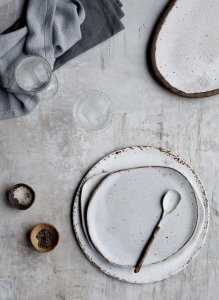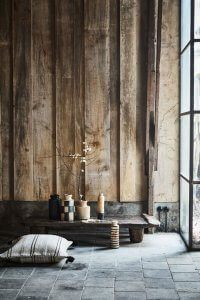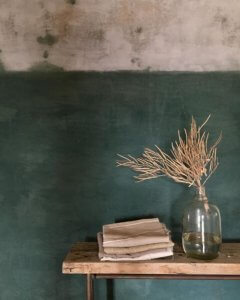The Wabi Sabi Style: A New Decor Trend

Today, we want to tell you a little bit about the Wabi Sabi style, and how to use it for interior design. The basis of this decor philosophy is to find the beauty in things that are imperfect, or even incomplete.
Another big part of this is the idea of transience, the lack of permanence. That’s why there’s such an emphasis on “imperfect,” incomplete, rough, and asymmetrical objects. But that doesn’t mean they aren’t beautiful. That, right there, is the essence of this philosophy.
Obviously, that imperfection could be entirely natural, or intentional. What we mean is that something could be imperfect because of the limitations of the design process or materials, or simply from the passage of time, which leaves its mark on everything. The imperfection could also be on purpose, like the designers giving something an aged look.
Even though we’re just focusing on interior design, the Wabi Sabi style has also become popular in art.

Is there a style similar to Wabi Sabi?
If you search for images of Wabi Sabi style decoration, you’ll probably see some similarities to other, more Western styles. This makes it very easy to use this style and still have a unified, simple, natural space with that touch of imperfection we just mentioned.
There’s a clear parallel with minimalism, although there are some differences. One major similarity is that everything should be practical and functional. They both say you shouldn’t clutter up spaces with useless objects or too much furniture and accessories. Visually speaking, you want to have less furniture, even if they’re big pieces.
Less is more.
-Mies van der Rohe-
You want to have big, open spaces–think of a New York City loft. You could knock down some walls in your home to create fewer rooms, and make the ones you have bigger. If you can, it’s also great to install some large windows.
You want your furniture and accessories to have a natural look. One of the best ways to get that is to by things made of untreated wood, natural fibers, or micro-cement.
It’s okay for the imperfections to be visible. That’s the whole point! You can buy wood with obvious grains and knots–all you need to do is sand and varnish it to prevent splinters.
It’s the same with natural fibers. You can buy handmade furniture and accessories, even if they’re unpainted. This also makes Wabi Sabi similar to the rustic and industrial styles in interior design.
The half-painted look
This doesn’t just go for furniture and accessories, it can work for walls and floors too. Whatever floor material you choose (wood, tile, etc), you don’t have to worry too much about putting it in perfectly. Asymmetry can actually look really nice here. You also don’t need to worry about the whole surface being the same color.
It’s the same with walls. The half-painted look is great for both furniture and walls. What it means is dividing your wall with stripes of different colors, or just leaving some parts unpainted.
You could do it in a monochromatic palette to make it a bit less uniform. We like it best when the divide between the two colors isn’t completely clear, or when you leave a bit of the bare wall visible, with its original color.
The best colors for this are grays, earth tones, blues, and whites. Again, you don’t need to worry too much about the colors running into each other–that’s part of the look.

Kintsugi: the art of repairing things with gold
The last thing we want to talk about with the Wabi Sabi style are accessories. Ceramic objects like jars and bowls are perfect for this decor scheme. Just like the things above, it’s okay if they’re notched or incomplete.
Just to give you an idea of how far it takes this love of imperfection and incompleteness, we’re going to tell you a bit about the Japanese art of kintsugi. This art involves putting broken ceramic objects back together with gold powder.
You can also do this with your fabrics, so it’s worth keeping in mind when you’re picking out curtains, rugs, etc…
Cracks and imperfections are a beautiful reminder that objects have history. If you don’t have anything like this, you can always go to a second-hand store.
This philosophy also applies really well to life in general: time goes by and affects you in all kinds of unexpected ways. We hope this article has give you some inspiration for your next decor project!
Today, we want to tell you a little bit about the Wabi Sabi style, and how to use it for interior design. The basis of this decor philosophy is to find the beauty in things that are imperfect, or even incomplete.
Another big part of this is the idea of transience, the lack of permanence. That’s why there’s such an emphasis on “imperfect,” incomplete, rough, and asymmetrical objects. But that doesn’t mean they aren’t beautiful. That, right there, is the essence of this philosophy.
Obviously, that imperfection could be entirely natural, or intentional. What we mean is that something could be imperfect because of the limitations of the design process or materials, or simply from the passage of time, which leaves its mark on everything. The imperfection could also be on purpose, like the designers giving something an aged look.
Even though we’re just focusing on interior design, the Wabi Sabi style has also become popular in art.

Is there a style similar to Wabi Sabi?
If you search for images of Wabi Sabi style decoration, you’ll probably see some similarities to other, more Western styles. This makes it very easy to use this style and still have a unified, simple, natural space with that touch of imperfection we just mentioned.
There’s a clear parallel with minimalism, although there are some differences. One major similarity is that everything should be practical and functional. They both say you shouldn’t clutter up spaces with useless objects or too much furniture and accessories. Visually speaking, you want to have less furniture, even if they’re big pieces.
Less is more.
-Mies van der Rohe-
You want to have big, open spaces–think of a New York City loft. You could knock down some walls in your home to create fewer rooms, and make the ones you have bigger. If you can, it’s also great to install some large windows.
You want your furniture and accessories to have a natural look. One of the best ways to get that is to by things made of untreated wood, natural fibers, or micro-cement.
It’s okay for the imperfections to be visible. That’s the whole point! You can buy wood with obvious grains and knots–all you need to do is sand and varnish it to prevent splinters.
It’s the same with natural fibers. You can buy handmade furniture and accessories, even if they’re unpainted. This also makes Wabi Sabi similar to the rustic and industrial styles in interior design.
The half-painted look
This doesn’t just go for furniture and accessories, it can work for walls and floors too. Whatever floor material you choose (wood, tile, etc), you don’t have to worry too much about putting it in perfectly. Asymmetry can actually look really nice here. You also don’t need to worry about the whole surface being the same color.
It’s the same with walls. The half-painted look is great for both furniture and walls. What it means is dividing your wall with stripes of different colors, or just leaving some parts unpainted.
You could do it in a monochromatic palette to make it a bit less uniform. We like it best when the divide between the two colors isn’t completely clear, or when you leave a bit of the bare wall visible, with its original color.
The best colors for this are grays, earth tones, blues, and whites. Again, you don’t need to worry too much about the colors running into each other–that’s part of the look.

Kintsugi: the art of repairing things with gold
The last thing we want to talk about with the Wabi Sabi style are accessories. Ceramic objects like jars and bowls are perfect for this decor scheme. Just like the things above, it’s okay if they’re notched or incomplete.
Just to give you an idea of how far it takes this love of imperfection and incompleteness, we’re going to tell you a bit about the Japanese art of kintsugi. This art involves putting broken ceramic objects back together with gold powder.
You can also do this with your fabrics, so it’s worth keeping in mind when you’re picking out curtains, rugs, etc…
Cracks and imperfections are a beautiful reminder that objects have history. If you don’t have anything like this, you can always go to a second-hand store.
This philosophy also applies really well to life in general: time goes by and affects you in all kinds of unexpected ways. We hope this article has give you some inspiration for your next decor project!
All cited sources were thoroughly reviewed by our team to ensure their quality, reliability, currency, and validity. The bibliography of this article was considered reliable and of academic or scientific accuracy.
Lázaro, Sofía. “La imperfecta BELLEZA de la casa WABI SABI“. Revista Architectural Digest. 2018. Información disponible en el siguiente enlace: https://www.revistaad.es/decoracion/casas-ad/articulos/la-imperfecta-belleza-de-la-casa-wabi-sabi/20411
Josch, Melody. Las grietas de la filosofía kintsugi en el diseño textil. Convivencia entre lo industrial y artesanal (Trabajo de Fin de Grado). Universidad de Palermo (Argentina), 2017. Información disponible en el siguiente enlace: http://fido.palermo.edu/servicios_dyc/blog/alumnos/trabajos/13559_12902.pdf







